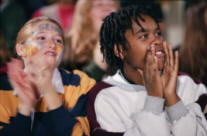Lessons learned from school violence events:
Most school shootings last about 2 minutes. Rapid response (RAID- Rapid and Immediate Deployment) is more effective than tactical response (SWAT Teams) in active violence events. Much criticism was leveled at the Jefferson County (Littleton/Columbine) Sheriff’s Department for a slow reaction. Law enforcement is now trained to deploy immediately in a diamond formation and seek out and “resolve” the problem.
Good communication saves lives. At the Littleton event 5 different law enforcement agencies converged on the scene and none of them could communicate with each other. As a result common communication links between agencies have been developed.
This issue of effective communication correlates to educational planning as well. For example we’ve learned that classroom phones need to have the exact procedure for dialing 9-1-1 on them; including the number necessary to connect to an outside line. Another example is for LEA’s to provide all law enforcement agencies updated maps of facilities; with all of the new construction schools have initiated many responding agencies would not be familiar with the building lay-out.
Perhaps just as importantly, crisis plans need to be developed based on relevance and timeliness (plans must be meaningful to participants). Each staff member must be trained and drilled in exactly what is expected of them and instructions should be printed in short specific terms and large font. Studies indicate that 90% of training will be lost on participants during real crisis.
An interesting study note from Littleton was that of all the cell phone calls made during the crisis 70% were made to 9-1-1; 30% were made to the media. Asked why they called the media the primary reason given was that students received “free cell minutes” if they reported a crime.
Crisis creates chaos. Several examples illustrate this point; let’s look at the Jonesboro, Ark. event. Two facts placed more people in harms way than would have otherwise occurred. First, in order to obtain targets for their attack one of the shooters ran inside the building and pulled a fire alarm, thus creating a steady flow of targets from the building. To compound the situation the doors automatically locked after a predetermined amount of time, thus depriving the students/teachers an opportunity to seek shelter (reverse evacuation). This reverse evacuation planning has saved lives as a result of drive-by shootings in Florida and California.
Secondly, word spreads very quickly and parents respond immediately. Perimeters don’t work and rural areas represent the greatest risk. In Jonesboro as 90 shots rang out and 14 victims fell the traffic backup was so snarled that the closest an emergency vehicle could get to the scene was 1/3 of a mile (300 yards).
As such parent re-unification plans and alternate sites must be written into any crisis plan.
 Never call off activities. For years psychologists have pleaded with schools to be careful of memorials and funerals in school buildings because many children will always associate the loss with the location. Although appropriate means of bereavement need to be made available schools must realize that schools need to return to a safe and “normal” place as soon as possible. Studies of school violence now teach us that many of the shooters associate memorializing with the previously mentioned inequity issue. A recent hostage negotiation situation in Tennessee illustrates this point. The juvenile offender was embittered because the untimely death of a star athlete had been memorialized while the death of a marginal student had not. This was interpreted as labeling one death appropriate and the other not.
Never call off activities. For years psychologists have pleaded with schools to be careful of memorials and funerals in school buildings because many children will always associate the loss with the location. Although appropriate means of bereavement need to be made available schools must realize that schools need to return to a safe and “normal” place as soon as possible. Studies of school violence now teach us that many of the shooters associate memorializing with the previously mentioned inequity issue. A recent hostage negotiation situation in Tennessee illustrates this point. The juvenile offender was embittered because the untimely death of a star athlete had been memorialized while the death of a marginal student had not. This was interpreted as labeling one death appropriate and the other not.
Researchers from the Secret Service (Safe School Initiative) have completed a detailed analysis of 37 school shootings. Here are some of the findings[1]:
Planning. They don’t “snap.” The attacks were neither spontaneous nor impulsive. In almost all cases the attacker developed the idea well in advance. Half considered the attack for at least two weeks and had a plan for at least two days. Two years before the Littleton event Dylan Klebold wrote in his journal, “I’ll go on my killing spree against anyone I want.” One student showed his friends four bullets; three for people he hated and one for himself. And that’s just the way he used them.
Concern. Almost all attackers had come to the attention of someone (school officials, police, fellow students) for disturbing behavior. One student worried his friends by talking often of putting rat poison in the cheese shakers at a pizza restaurant. Others wrote poems about homicide and suicide.
Adults didn’t investigate, remaining unaware of the depth of the problem. Few of the boys had close relationships with adults. Few participated in organized activities and most often the likely original targets were girls.
Before Littleton, the local Sheriff had been given copies of Eric Harris’ web site, describing his pipe bombs, with page after page of threats: “You all better f-------- hide in your houses because I’m comin for EVERYONE soon, and I WILL be armed to the f----- teeth and I WILL shoot to kill and I WILL F----KILL EVERYTHING.”
Communication. They aren’t “loners.” In more than three fourths of the cases, the attacker told someone about his interest in mounting an attack at school. In more than half of the incidents, the attacker told more than one person. Some people knew detailed information, while others knew something “spectacular” was going to happen on a particular date. These communications were usually with friends or schoolmates; in only two cases was the confidant an adult. In less than one-fourth of the cases did the attacker make a direct threat to the target. “I’m going to kill her sometime today or tomorrow,” a student warned.
 Bystanders. Those who knew in advance of the attack sometimes encouraged the attack and sometimes urged an escalation of the plan, but only rarely told anyone or shared their concerns with others before the attack. In about one-third of the cases, the attack was influenced or dared by others or a group. A friend of Harris asked him what he was going to do with bomb-making equipment. “He said he was going to blow up the school.” A friend of one shooter was told what would happen. “I was his friend. Calling someone would have been a betrayal. It just didn’t seem right to tell.”
Bystanders. Those who knew in advance of the attack sometimes encouraged the attack and sometimes urged an escalation of the plan, but only rarely told anyone or shared their concerns with others before the attack. In about one-third of the cases, the attack was influenced or dared by others or a group. A friend of Harris asked him what he was going to do with bomb-making equipment. “He said he was going to blow up the school.” A friend of one shooter was told what would happen. “I was his friend. Calling someone would have been a betrayal. It just didn’t seem right to tell.”
Mental Illness. Few shooters have been diagnosed with a mental illness, or had histories of drug or alcohol abuse. But more than half had a history of feeling extremely depressed or desperate. About three-fourths threatened to kill themselves, made suicidal gestures or tried to kill themselves before the attack. Six killed themselves during the attack. Luke Woldham’s journal: “I am not insane. I am angry. I am not spoiled or lazy, for murder is not weak and slow-witted, murder is gutsy and daring… I killed because people like me are mistreated every day…I am malicious because I am miserable.”
Woodham says now, “I didn’t really see my life going on any further. I thought it was all over with…I couldn’t find a reason not to do it.”
Motives. Many shooters had more than one motive. The most frequent motivation was revenge. More than three-fourths were known to hold a grievance, real or imagined, against the target and/or others. In most cases, this was the first violent act against the target. In his journal, Kip Kinkel of Springfield Ore., wrote, “Hate drives me…I am so full of rage…Everyone is against me…As soon as my hope is gone, people die.” Eric Houston wrote: “My HATEtrid tord humanity forced me to do what I did…I know parenting had nothing to do with what happens today. It seems my sanity has slipped away and evil taken it’s place…And if I die today please bury me somewhere beautiful.”
Problem Solving. Many saw the attack as a way to solve a problem. Bullying was common. Two-thirds of the attackers felt persecuted, bullied or threatened- not teasing but torment. Other problems they were trying to solve: a lost love, an expulsion or suspension, even a parent planning to move the family. Loukaitis: “Some day people are going to regret teasing me.” “I just remember life not being much fun,” a shooter recalls. “Reject, retard, loser.” I remember ‘stick boy’ a lot; because I was so thin.” Houston: “Maybe to open up somebody’s eyes to see some of the stuff that goes on…of how the school works, and make them understand a little bit some of the stuff I went through.”
 Stress. In more than three-fourths of the incidents, the attackers had difficulty in coping with a major change in a significant relationship or loss of status, such as a lost love or a humiliating failure. Woodham: “I actually had somebody I loved and somebody loved me for the first time in my life, the only time in my life. And then she just, all of a sudden one day she broke up with me and I was devastated, I was going to kill myself.”
Stress. In more than three-fourths of the incidents, the attackers had difficulty in coping with a major change in a significant relationship or loss of status, such as a lost love or a humiliating failure. Woodham: “I actually had somebody I loved and somebody loved me for the first time in my life, the only time in my life. And then she just, all of a sudden one day she broke up with me and I was devastated, I was going to kill myself.”
Targets. These weren’t rampage killers. Many of the killers made lists of targets, even testing different permutations of the order of the killing. Students, principals, and teachers- all could be targets. In about half of the cases, the actions appeared designed to maximize the number of victims. Scott Pennington said he did not dislike his English teacher, Deanna McDavid, whom he killed in Grayson, Ky. His writings had concerned her; she shared her concerns with the school board, which told her it was his family’s responsibility to get him help.
Violence. Most were not bullies, were not frequently in fights, were not victims of violence, had not harmed animals. Six in ten showed interest in violent video themes in media, games, or, more frequently, their own writings. Scott Pennington said he read Stephen King’s “Rage,” about a school murder, after his violent act, not before as has been reported.
 Weapons. Getting weapons was easy. Most of the attackers were able to take guns from their homes or friends, buy them (legally or illegally), or steal them. Some received them as gifts from parents. More than half had a history of gun use, although most did not have a “fascination” with weapons. “F---- you Brady.” Eric Harris wrote in his journal about the Brady gun bill. “All I want is a couple of guns and thanks to your f--- bill I will probably not get any! Come on, I’ll have a clean record and I only want them for personal protection. It’s not like I’m some psycho who would go on a shooting spree.”
Weapons. Getting weapons was easy. Most of the attackers were able to take guns from their homes or friends, buy them (legally or illegally), or steal them. Some received them as gifts from parents. More than half had a history of gun use, although most did not have a “fascination” with weapons. “F---- you Brady.” Eric Harris wrote in his journal about the Brady gun bill. “All I want is a couple of guns and thanks to your f--- bill I will probably not get any! Come on, I’ll have a clean record and I only want them for personal protection. It’s not like I’m some psycho who would go on a shooting spree.”
Police. Most incidents were brief. Almost two-thirds of the attacks were resolved before police arrived. The attacker was stopped by a student or staff member, decided to stop on his own, or killed himself. SWAT teams would not have helped. In only three cases did police discharge their weapons.
[1] Adapted from a Chicago Sun-Times article provided by Dr. Dudley